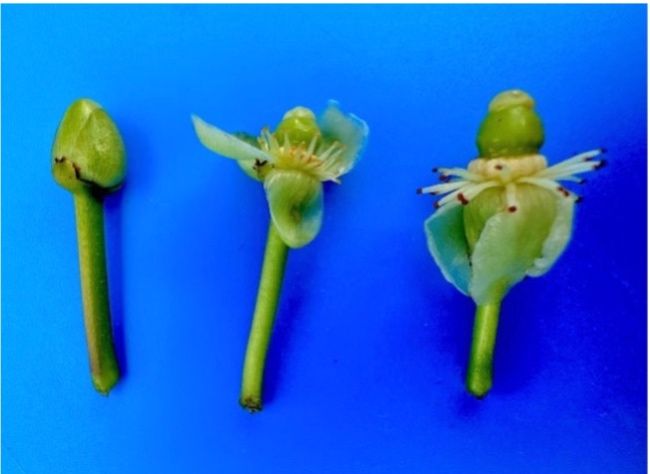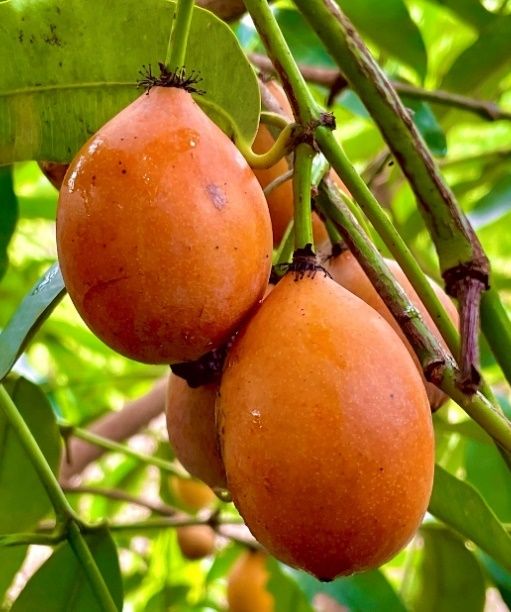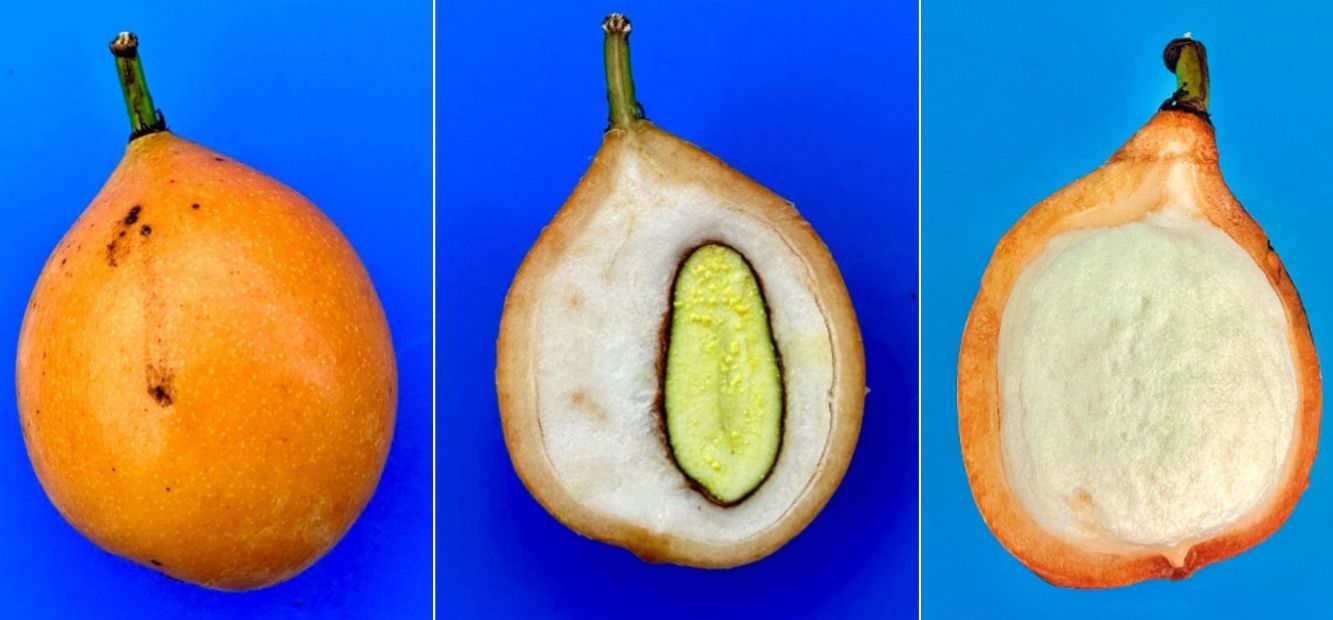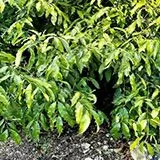Achachairú (Garcinia humilis) Fruit Trees: Botany and Commercial Cultivation in South Florida
Introduction
The achachairú (Garcinia humilis) is a slow-growing understory tropical fruit tree from the Amazonian forests in Bolivia and South America. It produces a delicious fruit that is harvested from cultivated and wild trees. Although it is relatively unknown outside its endemic areas, it has significant commercial potential, and its cultivation has extended to countries such as Brazil, Mexico, and Australia. The achachairú can be grown in south Florida. This article provides detailed information on the achachairú’s characteristics, botany, and recommended horticultural practices for commercial growers and county and state Extension faculty in south Florida and is also applicable for homeowners and students interested in growing achachairú.
Scientific Name
Garcinia humilis [(Vahl) C.D. Adams]
Common Name
Achachairú, Bolivian mangosteen, orange mangosteen
Family
Clusiaceae
Relatives
The genus Garcinia includes around 300 species with worldwide distribution. Several species in this genus produce delicious edible fruit, such as the mangosteen (Garcinia mangostana) and the cherapu (Garcinia prainiana) from Asia; the charichuela (Garcinia madruno) and the bacupari (Garcinia brasiliensis) from South America; and the imbe (Garcinia livingstonei) from Africa.
Origin and Distribution
The achachairú originated in the lowland Amazonian regions of eastern Bolivia. Wild populations are found dispersed throughout the Amazonian region and other tropical areas of South and Central America. This species is not at all invasive and is not on the new state or federal list of invasive or potentially invasive species.
History
The word achachairú means “honey kiss” and comes from the Guarani language spoken in Bolivia and Paraguay. It has been a revered crop consumed by Amazonian peoples since prehistoric times. Its popularity has been confined to local communities until the last few decades, when its excellent qualities and commercial potential have made it more popular in tropical and subtropical countries around the world.
Importance
The achachairú is an important fruit crop in Bolivia, where it is harvested from wild trees and backyard plantations mostly around the Santa Cruz area, covering over 5,000 acres (2,000 ha) and with an estimated annual production of 100 tons (90.7 metric tons). In Queensland, Australia, there are 16,000 trees planted covering over 300 acres (120 ha), and it is a popular tropical fruit sold in local markets when in season. As of 2023, there are reports that achachairú is being planted in increasing numbers in several countries including Brazil, Mexico, and Guatemala, but no information is available in terms of crop volume or economic importance.
Description
Tree
The achachairú is a medium-sized tree that grows wild in the tropical and subtropical forests of South America. It is an understory, slow-growing tree that can reach a height of 24 to 30 ft (7 to 9 m) and grows in full sun or in areas partially shaded by larger trees. It has marked apical dominance (orthotropic growth), coupled with vigorous and long horizontal branches (plagiotropic growth), which results in a characteristically conical shape with a broad base. It has a main cylindrical trunk with a mature diameter of 8 to 14 inches (20 to 36 cm).

Credit: Federico Sanchez, UF/IFAS TREC
Leaves
Leaves are dark green, opposite, glabrous, coriaceous, elliptical, and lanceolate, with acuminate apices and acute bases. They are approximately 8 inches (20 cm) long, by 2.8 inches (7 cm) wide. New leaves emerge in pairs from the tips of the branches in 2 to 4 irregularly timed flushes during the year. New leaves have an intense copper or crimson color, which changes to light pink, light green, and finally, dark green as the leaves reach their maximum length.

Credit: Federico Sanchez, UF/IFAS TREC
Flowers
The achachairú flowers are self-fertile, hermaphroditic, and occasionally male. Flowers emerge from branch nodules in groups of 5 to 10. Each flower is approximately 1 inch (25 mm) in diameter, has white-green petals, and has one ovary which is 0.2 inch (5 mm) in diameter and is surrounded by approximately 20 stamens.

Credit: Federico Sanchez, UF/IFAS TREC
Fruit
The achachairú fruit is a berry with an ovoid shape. It is around 2.4 inches (6 cm) long by 1.8 inches (4.6 cm) wide, with an approximate weight of 1.8 ounces (51 g). The pulp or endocarp has a soft, mucilaginous texture with a very appealing balance of sweetness and acidity, an approximate Brix of 16°, and a pH of 4.0, and it accounts for 40% of the total fruit weight. The skin or exocarp consists of a thick, dark-orange coriaceous (leathery) rind, which accounts for 48% of the total fruit weight, opens easily, and completely separates from the pulp. The fruit has one to three polyembryonic or monoembryonic seeds (usually one large and two aborted) with a cylindrical shape and approximate size of 1.2 inches x 0.8 inch (3 cm x 2 cm). The seeds account for approximately 12% of the total fruit weight (Ardaya 2009; Barbosa et al. 2008; Janick and Paull 2008; Melo et al. 2017; Oliveira et al. 2019).

Credit: Federico Sanchez, UF/IFAS TREC

Credit: Federico Sanchez, UF/IFAS TREC
Pollination
Achachairú flowers are self-fertile and open in the morning hours when they are pollinated by insects, most likely bees, beetles, and flies.
Varieties
While there is significant phenotypic variation in achachairú trees from different provenances, there are no documented named varieties that are recognized for their unique and consistent characteristics.
Climate
Wild achachairú trees are found in tropical and warm subtropical forests, at elevations up to 1,800 ft (550 m), with an average temperature of 74°F to 78°F (23°C to 26°C), and 60 to 80 inches (1,500 to 2,000 mm) of annual precipitation.
Environmental Requirements
Temperature
Short periods of low temperatures around 40°F to 50°F (4°C to 10°C) do not seem to significantly affect achachairú, but its tolerance to temperatures that are close to freezing has not been investigated. Sustained low temperatures can cause the leaves to turn light green and yellow due to low absorption of iron and other nutrients (winter chlorosis). Cold temperatures and dry, cold winds during the flowering periods can cause significant loss of flowers and fruitlets.
Flooding and Salinity
Achachairú trees exhibit some tolerance to saline soils and are tolerant of flooding with fresh or saline water (4 dSm-1) for periods of up to 30 days, which results in significant but not fatal reduction in the plant’s physiological functions (F. Sanchez, unpublished data).
Drought
Achachairú trees can survive short drought periods, but insufficient or infrequent access to water results in few flowers and low fruit set, with reported decreases in fruit yield of up to 80% during dry years.
Wind
The achachairú is not native to areas with strong winds and exhibits limited resistance to strong or dry winds. It is particularly susceptible to uprooting by winds during the initial years after planting and before it has developed a strong root system. The use of natural wind barriers to prevent mechanical damage, uprooting, or desiccation of the trees is highly recommended when planting in large open areas or in zones prone to strong or dry winds (Ardaya 2009).
Propagation
Achachairú trees are propagated mainly by seed. Seeds should be cleaned well, planted in a pot filled with sterile potting media, and covered by 0.5 inch (1.25 cm) of media. Seeds take three to six months to germinate. The media should be kept moist, and temperatures should be maintained between 80°F and 85°F (27°C–30°C) during this period. The emergence of the first pair of leaves occurs three weeks after root germination, and a second flushing usually occurs eight months later. Rooting cuttings and air-layering are not effective ways of propagation. Research has demonstrated that while grafting achachairú is possible, it is not recommended because it results in poor tree architecture and does not seem to accelerate the fruit-bearing stage (Ardaya 2009).
Production (Crop Yields)
The achachairú produces one heavy crop per year, with a ripening period that lasts for approximately 90 days. The tree requires 7 to 8 years and a height of 6 to 9 feet (2 to 3 m) before it starts bearing fruit. Yields increase quickly to 2,000–4,000 fruit per tree during the initial years (220–440 lb or 100–200 kg per tree). Producers in Bolivia report average yields of 11,000 fruit for mature trees (1,200 lb or 550 kg per tree), with some trees reportedly producing up to 18,000 fruit. A single branch 6 to 9 ft in length (2 to 3 m) can produce 50 to 100 fruit.
Spacing
While the achachairú is a slow-growing tree, it can grow up to a height of 25 to 40 ft (8 to 12 m). Achachairú trees can have a canopy, which is wider than taller due to the vigorous horizontal growth of its branches. A spacing of 30 feet (9 m) is recommended between trees and between these and buildings or other structures. A planting density of 40 to 65 trees per acre (100 to 160 trees per ha) is recommended.
Soils
Achachairú is tolerant of a variety of soils, but it grows best in fertile, loamy soils with high organic matter content and an acidic to neutral pH of 5 to 7. Trees grown in the calcareous, high-pH soils of south Florida tend to develop iron and nutrient deficiencies which can be resolved with proper application of chelated iron as recommended below.
Soil pH
When grown in calcareous soils with a pH of 7 or higher, achachairú is prone to nutrient deficiencies of iron, zinc, and boron which may be corrected with foliar sprays and root drenches. New leaves are susceptible to damage by abiotic factors such as low temperature and dry winds, which result in small or deformed leaves, or leaves with brown, burned areas.
Planting an Achachairú Tree
Achachairú trees for planting in the field should be started by germinating seeds in containers as described above. Seedlings do not tolerate full sunlight and should be grown under 50% shade or indirect light until they reach a height of approximately 3 ft (1 m). It takes 2 to 4 years for the seedlings to reach this height, at which point they should be transplanted into the ground to prevent malformations of the large taproot which can become irreparably coiled inside the planting container (“root-bounding”). Achachairú seedling trees may occasionally be found for sale in south Florida nurseries. Select a healthy tree, free of diseases and pests, and avoid larger trees in small containers.
Site Selection
Once achachairú trees reach 3 to 4 ft (1 to 1.2 m) in height, they can be planted in the soil in full sun or under partial shade. A location with deep, rich, and moist soil will provide ideal growing conditions. Select an open area of at least 25 ft away from buildings, power lines, and other structures.
Staking
Achachairú trees should develop a strong pyramidal architecture as they grow. Stake the tree for up to 9 months after transplanting to ensure upright growth and provide stability while the slow-growing taproot develops. Loosely tie the bottom two-thirds of the main trunk to a bamboo or wooden stake with degradable staking tape or cotton string.
Planting in Sandy Soil
Eliminate the grass sod or weeds to form a circle with a diameter of 5 to 10 feet (1.5 to 3 m). Dig a hole four times the diameter and four times as deep as the container of the achachairú tree. Backfill the hole with the excavated soil, or if desired, mix compost or topsoil with the soil excavated from the hole in a 1:1 proportion. Remove the tree from the container and position it in the center of the hole, ensuring that the level of the soil in the container is at the same level or slightly above the soil level of the new hole.
Planting in Very Gravelly Loam (Krome) Soil in South Florida
Some areas in south Florida have only a few inches of topsoil over a hard bedrock of limestone. In these cases, it is necessary to use a backhoe, auger, or pick to dig a hole at least four times the diameter and four times as deep as the container of the achachairú tree, and to then proceed with the steps listed in the section on planting in sandy soil.
Planting on a Mound
In low-lying areas prone to flooding for extended periods of more than 2 to 3 days, consider planting achachairú trees on top of a mound built with native topsoil up to 2 to 3 ft (0.6 to 0.9 m) above the soil grade, and then follow the recommendations described above for sandy or very gravelly loam soil.
Mulching
Mulching with pine bark or wood chips is recommended to conserve the humidity of the soil, reduce weeds, and increase the organic matter content of the soil. A mulch layer of 2 to 4 inches (5 to 10 cm) should be maintained under the tree canopy, but mulch should be separated by 10 inches (25 cm) from the trunk to prevent fungal diseases.
Care of Achachairú Trees in the Home Landscape
Fertilization
While optimal fertilization guidelines have not been developed for achachairú trees in Florida, fertilization suggestions can be made based on the personal experience of local growers. Because achachairú trees grow slowly and flush infrequently, a slow-release balanced fertilizer with an analysis of 6-6-6-2 (N-P-K-S) or similar material should be applied three times per year from February to October (Table 1). Applications of ferrous sulfate to soils with a neutral to acid pH are recommended. Root drench applications with a solution of chelated (EDDHA formulation) iron are highly recommended for trees planted in calcareous, high-pH soils to prevent iron deficiencies, and should be implemented four times per year from February to October. Foliar sprays with a formula including zinc, magnesium, manganese, molybdenum, and boron are recommended four times per year from February to October (Table 1).
Table 1. Fertilizer program for achachairú trees in the home landscape.
Irrigation (Watering)
The specific water requirements of achachairú for south Florida have not been determined, but trees grow best if abundant water is available year-round. Trees are affected quickly by insufficient watering. Smaller trees grown in containers are very susceptible to water stress and should be watered with at least 1 gallon (4 L) of water per plant every other day. Newly transplanted trees in the soil should be watered generously every 2 to 3 days for the first 1 to 3 months. Established trees should be provided with sufficient water from rain or irrigation twice weekly year-round. Insufficient watering will limit vegetative growth, prolong the transition to the reproductive phase, decrease flowering, and increase fruit drop.
Insect Pests
Achachairú trees are minimally affected by pests. Aphids are small insects from the Aphididae family which feed on the sap of plants and may occasionally attack the new flushes of achachairú trees. Aphids may be observed as small green, whitish, or brown insects on buds and the underside of new growth. Damage results in deformed and curled leaves, which may also be covered with a black, sooty mold. New growth should be inspected for aphids. If insects are observed, weekly spraying with an organically-certified biological insecticide (such as BotaniGard®) should be started and maintained until the insect’s population has been eliminated. The conehead termite (Nasutitermes corniger) is an insect that nests around the trunks of achachairú trees in South America. While no problems with conehead termites have been observed in Florida, this insect is the first non-endemic termite to be established in south Florida (Scheffrahn et al. 2002). Removal of the underground colonies of conehead termites is necessary if these insects are observed.
Diseases
Very few diseases have been reported to affect the achachairú. Anthracnose (Colletotrichum gloeosporioides) occasionally attacks achachairú trees under conditions of excessive moisture and poor ventilation. Anthracnose can cause defoliation and fruit rot, and it is characterized by the formation of round, dark-brown lesions with a yellowish border in fruit and leaves (Hablemosdeflores.com 2019). Anthracnose is usually not a significant problem for achachairú in Florida, and the application of fungicides is not recommended.
Pruning
Pruning is not recommended at any stage, except to remove diseased or damaged branches, or low branches that contact the soil and promote disease.
Phenology
In south Florida, flowering, pollination, and fruit set occur in 2 to 3 flushes during late winter and early spring from February to March. Fruit growth follows a sigmoid curve, taking 3 to 4 months to reach maximum size, with minimal fruit drop under ideal conditions. Immature fruit are green and change color to yellow and light orange 3 to 4 weeks before reaching a deep dark-orange color at full fruit maturity. Fruit ripening extends for a period of 2 to 3 months between May and August. Vegetative growth flushes occur 2 to 3 times per year and are unevenly spaced every 60 to 100 days, when most branch tips flush with a new pair of leaves and produce a 4-inch to 10-inch (10-cm to 25-cm) elongation of branches.
Harvest, Ripening, and Storage
Achachairú fruit is non-climacteric (i.e., they ripen on the tree) and should not be harvested before they have developed a dark-orange peel. Fruit with a light-orange color have not reached maximum sweetness and, although edible, will have a more acidic taste. Achachairú fruit does not fall off the tree, and once the fruit has reached peak ripening, there is usually a 2- to 3-week window for harvesting before the flavor, color, and texture start deteriorating, and the fruit begin turning brownish and bitter. Individual fruit can be harvested by clipping the stem (peduncle) 0.5 inch (1 cm) above the fruit. Once harvested, the fruit is very resilient to storage and transport. It can be stored at ambient temperatures of 70°F to 75°F (21°C to 24°C) for up to two weeks, but it deteriorates quickly at higher temperatures. Fruit can be stored for up to six weeks under controlled environment conditions, with temperatures kept between 55°F and 65°F (13°C–18°C) and a relative humidity of 80% (Cotty-Más et al. 2019; Duarte 2011).
Uses and Nutritional Value
Achachairú fruit are delicious when consumed fresh. The rind can be separated into two halves, exposing the white inner pulp which separates easily from the skin. The pulp is eaten fresh, and also used to prepare jams and ice cream, sweet desserts, cakes, and cookies. The skin of the achachairú fruit is not commonly eaten fresh but can be made into a refreshing drink by processing it in a blender with water, sugar, and mint leaves, and straining. The seeds can be dried and made into flour that is high in starch, phenolic compounds, and dietary fiber (Ikeda et al. 2021). The rind has been studied for potential cardiovascular protection (John et al. 2018), gastroprotection (Mariano et al. 2016; Niero et al. 2012), and protection against leishmaniasis (a protozoan parasite transmitted by sandflies) (Filho et al. 2013). The fruit are used in traditional Amazonian medicine to treat inflammation, skin problems, and gastric disturbances, and to promote weight loss. Achachairú fruit are a good source of antioxidants, vitamins A, C, B1 (thiamine), and B9 (folic acid), phosphorus, and calcium.
References
Ardaya, B. D. 2009. El cultivo de Achachairú Garcinia humilis: Manual de recomendaciones. Centro de Investigación Agrícola Tropical (CIAT), Santa Cruz de la Sierra, Bolivia.
Barbosa, W., E. A. Chagas, L. Martins, R. Pio, M. L. S. Tucci, and F. A. Artioli. 2008. “Germinação de sementes e desenvolvimento inicial de plântulas de achachairú.” Rev. Bras. Frutic. 30:263–266. https://doi.org/10.1590/S0100-29452008000100049
Cotty-Más, M., R. Chavez-Jauregui, and L. Wessel-Beaver. 2019. “Postharvest Quality of Achachairú (Garcinia gardneriana) Stored at Ambient Temperature.” J. Agric. Univ. P. R.:155–172. https://doi.org/10.46429/jaupr.v103i2.18227
de Castro Oliveira, K. D., S. Sousa e Silva, J. W. A. Nunes, R. A. Loss, and S. F. Guedes. 2019. “Caracterização pós-colheita de frutos de achachairú (Garcinia humilis (Vahl) C. D. Adam) cultivados em Araputanga, Mato Grosso, Brasil.” Rev. Bras. Tecnol. Agroindustrial 13. https://doi.org/10.3895/rbta.v13n1.7893
Duarte, O. 2011. “Achachairú (Garcinia humilis (Vahl) C.D. Adam).” In Postharvest Biology and Technology of Tropical and Subtropical Fruits. 48–54e. Elsevier. https://doi.org/10.1533/9780857092762.48
Filho, V. C., C. Meyre-Silva, R. Niero, L. N. Bolda Mariano, F. Gomes do Nascimento, I. Vicente Farias, V. F. Gazoni, B. Dos Santos Silva, A. Giménez, D. Gutierrez-Yapu, E. Salamanca, and A. Malheiros. 2013. “Evaluation of Antileishmanial Activity of Selected Brazilian Plants and Identification of the Active Principles.” Evid.-Based Complement. Altern. Med. ECAM 2013:265025. https://doi.org/10.1155/2013/265025
Hablemosdeflores.com. 2019. "Achachairú: propiedades, fruto, ¿para qué sirve? y más.” Hablemos de Flores. https://hablemosdeflores.com/achachairu/
Ikeda, M., A. M. de Melo, B. P. Costa, R. C. T. Barbi, and R. H. Ribani. 2021. “Nutritional and Bioactive Composition of Achachairú (Garcinia humilis) Seed Flour: A Potential Ingredient at Three Stages of Ripening.” LWT 152:112251. https://doi.org/10.1016/j.lwt.2021.112251
Janick, J., and R. E. Paull. 2008. The Encyclopedia of Fruit and Nuts. Oxfordshire, UK: CABI. https://doi.org/10.1079/9780851996387.0000
John, O. D., S. Wanyonyi, P. Mouatt, S. K. Panchal, and L. Brown. 2018. “Achacha (Garcinia humilis) rind improves cardiovascular function in rats with diet-induced metabolic syndrome.” Nutrients 10:1425. https://doi.org/10.3390/nu10101425
Mariano, L. N. B., L. M. da Silva, P. de Souza, T. Boeing, L. B. Somensi, T. J. Bonomini, F. Delle Monache, V. Cechinel Filho, S. F. de Andrade, and R. Niero. 2016. “Gastroprotective Xanthones Isolated from Garcinia achachairu: Study on Mucosal Defensive Factors and H+, K+-ATPase Activity.” Chem. Biol. Interact. 258:30–39. https://doi.org/10.1016/j.cbi.2016.08.009
Melo, M.S., C. G. S. Benett, B. S. Melo, S. L. O. Lourenço, and F. S. Barboza. 2017. “Analise físico-química de frutos de achachairú coletados em diferentes partes da planta.” Rev. Agric. Neotropical 4:17–21. https://doi.org/10.32404/rean.v4i5.2189
Niero, R., M. M. Dal Molin, S. Silva, N. S. Damian, L. O. Maia, F. Delle Monache, V. Cechinel Filho, and S. F. de Andrade. 2012. “Gastroprotective Effects of Extracts and Guttiferone A Isolated from Garcinia achachairu Rusby (Clusiaceae) Against Experimentally Induced Gastric Lesions in Mice.” Naunyn. Schmiedebergs Arch. Pharmacol. 385:1103–1109. https://doi.org/10.1007/s00210-012-0788-1
Scheffrahn, R. H., B. J. Cabrera, W. H. Kern, and N.-Y. Su. 2002. “Nasutitermes costalis (Isoptera: Termitidae) in Florida: First Record of a Non-Endemic Establishment by a Higher Termite.” Fla. Entomol. 85:273–275. https://doi.org/10.1653/0015-4040(2002)085[0273:NCITIF]2.0.CO;2




